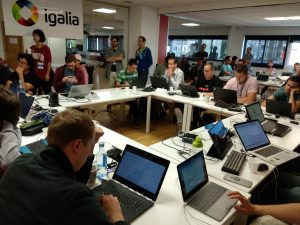I had the pleasure to attend the Web Engines Hackfest last week, hosted and organized by Igalia in its HQ in A Coruña. I’m really proud of what we are achieving with this event, thank so much to everybody involved in the organization but, specially, to the people attending. This year we had a lot of talent in a single place, hacking and sharing their expertise on the Web Platform; I really think we all have pushed the Web Platform forward during these days.
As you may already know, I’m part of the Web Platform team at Igalia working on the implementation of the CSS Grid Layout feature for Blink and WebKit web engines. This work has been sponsored by Bloomberg, as part of the collaboration we started several years ago to improve the Web Platform in many areas, from JS (V8, JSC and even ChakraCore) to different modules of the layout engine (eg. CSS features, editing/selection).
Since the day I received the invitation to attend the hackfest I knew that one of the tasks I wanted to hack on was the implementation of the CSS Grid feature in the new Chromium’s layout engine (still experimental), known as LayoutNG. Having Chistinan Biesinger, one of the Google engineers working on LayoutNG, here during 3 days was so good to let pass by the oportunity to, at least, start this task. I asked him to give a lighting talk during the layout breakout session about the current status of the LayoutNG project, a brief explanation of some of the most relevant details of its logic and its advantages with the current layout.
Layout Breakout Session
A small group of people interested on layout met to discuss about the future of layout in different web engines. I attended with some folks representing Igalia, and other people from Mozilla, Google, WebKit and ARM.
Christian described the key parts of the new LayoutNG, which provides a simpler code and generally better performance (although results are still preliminary since its under development phase). The concept of fragments gained relevance in this new layout model and currently, inline and block layout is basically complete; the multicolumn layout is quite advanced while Flexbox is still in the early stages (although a substantial portion of the layout tests are passing now).
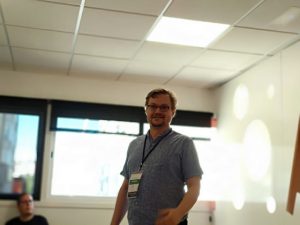 |
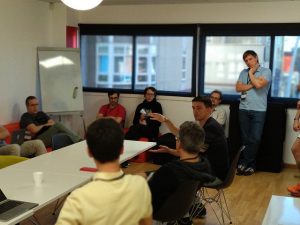 |
We discussed about the different strategies that Firefox, Chrome and Safari are following to redesign the layout logic, which has a huge legacy codebase required to support the old web along the last years. However, browsers need to adapt to the new layout models that a modern Web Platform requires. Chrome with LayoutNG implies a clear bet, with a big team and strong determination; it seems it’ll be ready to ship in the first months of 2019. Firefox is also starting to implement a new layout design with Servo, although I couldn’t get details about its current status and plans. Finally, WebKit started a few months ago a new project called Next-Generation layout which tries to implement a new Layout Formatting Context (LFC) logic from scratch, getting rid f the huge technical debt acquired during the last years; although I couldn’t get confirmation, my opinion is that it’s still an experimental project.
We also had time to talk about the effort ARM is doing towards a better parallelization of the CSS parsing and style recalc logic, following a similar approach to Mozilla’s Sylo in Servo. It’s a very intresting initiative, but still quite experimental. There is some progress on specific codepahts, but still dealing with Oilpan (Blink’s Garbage Collector) which is the root cause of several issues that prevents to obtain an effective parallelization.
Hacking, hacking, hacking, ….
As I commented, this event is designed precisely to gather together some of the most brilliant minds in the Web Platform to discuss, analyze and hack on complex topics that are usually very difficult to handle when working remotely. I had a clear hacking task this time, so that’s why I decided to focus a bit more on coding. Although I already had assumed that implementing CSS Grid in LayoutNG would be a huge challenge, I decided to take it and at least start the task. I took as reference the Flexible Box implementation, which is under development right now and something Christian was partially involved on.
As it happened with the Flexbible Box implementation, the first step was to redesign the logic so that we can get rid of the dependency of the old Layout Tree, in this case, the LayoutGrid class. This has ben a complex and long task, which took me a quite big part of my time during the hackfest. The following diagrams show the redesign effort achieved, which I’d admit is still a preliminary approach that needs to be refined:
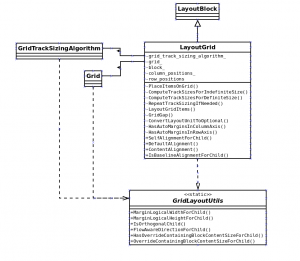 |
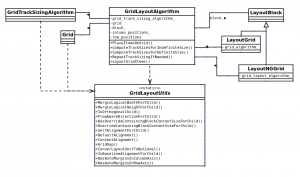 |
The next step was to implement an skeleton of the new layout-ng grid algorithm. Thanks to Christian’s direction, I quickly figure out how to do it and it looks like something like this:
namespace blink { NGGridLayoutAlgorithm::NGGridLayoutAlgorithm(NGBlockNode node, const NGConstraintSpace& space, NGBreakToken* break_token) : NGLayoutAlgorithm(node, space, ToNGBlockBreakToken(break_token)) {} scoped_refptr<nglayoutresult> NGGridLayoutAlgorithm::Layout() { return container_builder_.ToBoxFragment(); } base::Optional<minmaxsize> NGGridLayoutAlgorithm::ComputeMinMaxSize( const MinMaxSizeInput& input) const { // TODO Implement this. return base::nullopt; } } // namespace blink </minmaxsize></nglayoutresult> |
Finally, I tried to implement the Grid layout’s algorithm, according to the CSS Grid Layout feature’s specification, using the new LayoutNG APIs. This is the more complex tasks, since I still have to learn how sizing and positioning functions are used on the new layout logic, specially how to use the new Fragments and ContainerBuilder concepts.
I submitted a WIP CL so that anybody can take a look, give suggestions or continue with the work. My plan is to devote some time to this challenge, every now and then, but I can’t set specifc goals or schedule for the time being. If anybody wants to speed up this task, perhaps it’d be possible to fund a project, which Igalia would be happy to participate.
Other Web Engines Hackfest stories
I also tried to attend some of the talks give during the hackfest and participate in a few breakout sessions. I’ll give now my impression of some of the ones I liked more.
I enjoyed a lot the one given by Camille Lamy, Colin Blundell and Robert Kroeger (Google) about the Chrome’s Servicification project. The new services design they are implementing is awesome and it will improve for sure Chrome modularity and codebase maintenance.
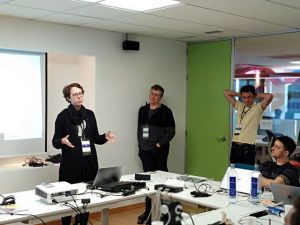 |
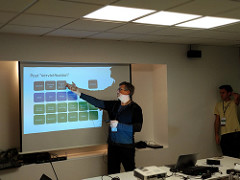 |
I participated in the MathML breakout session, which has somehow related to LayoutNG. Igalia launched a crowfunding campaign to implement the MathML specification in Chrome, using the new LayoutNG APIs. We thin that MathML could be a great success case for the new LayoutNG APIs, which has the goal of provide a stable API to implement new and complex layout models. This model will provide flexibility to the web engine, proving an easier way to implement new layout models without depending too much on the Chrome development cycle. In a way, this development model could be similar to a polyfill, but it’s integrated in the browser as native code instead of via external libraries.
